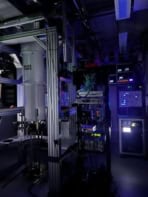
Physicists have demonstrated a large-scale, programmable quantum simulator, featuring a precisely-arranged two-dimensional array of 256 quantum bits (qubits). Designed by a team headed up at Harvard University, the system uses arrays of highly focused laser beams to trap individual atoms and drag them into desirable arrangements. The design, which the researchers describe in Nature, marks a key step forward in the global race to design larger, more reliable quantum computers, and could significantly improve their applicability in the near future.
Through the latest advances in quantum computing, researchers have recently demonstrated the potential for programmable quantum systems, capable of performing deeply complex simulations and computations. A promising platform for this technology can be found in arrangements of neutral, ultracold atoms individually trapped within arrays of optical tweezers. As their quantum states interact, these atoms can be used in operations including large-scale entanglement, quantum logic gates and realizing optical atomic clocks.
In 2017, the team developed a platform containing 51 ultracold rubidium atoms, arranged in a specific order using a one-dimensional array of optical tweezers. Building on this achievement, in their latest study the researchers aimed to develop a far more powerful two-dimensional arrangement of qubits. Although large numbers of atoms have already been trapped and rearranged in both two- and three-dimensional arrays, the coherent manipulation of programmable, strongly interacting systems containing over 100 qubits has remained far more challenging.
To overcome these difficulties, lead author Sepehr Ebadi and colleagues used a spatial light modulator to shape an optical two-dimensional wavefront, transforming the light into a uniform, two-dimensional array of highly focused laser beams that act as optical tweezers. After loading the beams with a random arrangement of ultracold rubidium atoms, they then used a second set of adjustable optical tweezers to drag the atoms into a defect-free antiferromagnetic arrangement – where the magnetic moment of each atom was exactly opposite to that of each of its neighbours.
Finally, the researchers used coherent optical beams to excite the atoms into their Rydberg states. In these states, the outer electron of the atom orbits at a large distance from its host nuclei, ensuring strong, highly tuneable interactions between individual qubits. In addition, they arranged the atoms in arrays of several different shapes, including square, honeycomb and triangular lattices. Each of these configurations featured a different type of interaction between qubits.

Quantum simulators shed new light on magnetic phase transitions
Altogether, the technique allowed the team to produce a highly programmable quantum simulator, containing up to 256 qubits – which together could occupy a vast number of possible quantum states.
In their future research, the physicists will aim to upgrade their setup even further, through a better control over each individual tweezer beam and making the system more programmable. These improvements could pave the way for a diverse range of applications: including advanced new ways to study strongly-correlated quantum matter, designing hardware suitable for running efficient quantum algorithms, and solving challenging real-world problems in computation and measurement.



